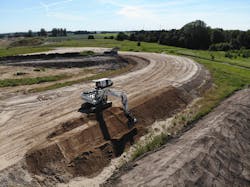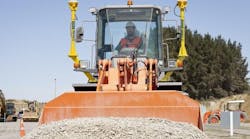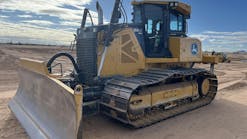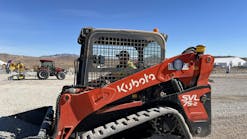Trimble side-by-side evaluations of excavator operators using conventional as well as guided methods of trenching produced data showing just how effective machine control can be. Two tests were held, one during a training session at the company’s Dayton, Ohio, headquarters, and the other on a highway project in Denmark. Excavators included a Caterpillar 329E in Denmark, and Komatsu PC228-10 and Hyundai HX220-L excavators in Ohio.
All three excavators were equipped with Trimble’s Earthworks Grade Control system with automatics capabilities. When the excavator is placed in “Autos” or automatics mode, the operator controls the stick, and Trimble Earthworks controls the boom and bucket to stay on grade. According to Trimble, the feature automates excavator operation and allows operators to achieve grade at a consistent rate, with high accuracy, and in much less time.
The two tests set out to try this hypothesis.
In Denmark, contractor MJ Eriksson employed the machine control system on a new-highway project that included a bridge across the Roskilde Fjord. Two operators were given the task of shaping a side slope according to the project design of 25 meters wide, meeting a tolerance of +/- 3 centimeters. Operators worked first without Trimble Earthworks automatics, then with. Crews measured 40 control points after each round using a Trimble SPS930 Universal Total Station to verify accuracy.
The first operator has 17 years of experience operating different pieces of heavy equipment, with 13 years operating primarily excavators. Without automatics, he did the task in 37 minutes with 43 percent accuracy within the tolerance. With the automatic function, he cut the time to 22 minutes and increased accuracy to 74 percent.
The second operator’s skill was labeled “beginner/intermediate,” as he had worked with machine control but only operated equipment from time to time. He identified himself as not skilled. Without automatics, this operator performed the task in 43 minutes with accuracy of 38 percent within tolerance. With the automatics engaged, his time improved to 31 minutes and accuracy moved to 75 percent.
Accuracy with both operators was similar with the automatics engaged, although the skilled operator completed the task more quickly.
Machine control training trials
In the Dayton study, Trimble used a week-long training course to evaluate not only automatics versus conventional operation, but also conventional against the guidance-only function of Trimble Earthworks Grade Control. The study included 16 operators over the course of the week.
The task was digging a half-meter trench 1 meter wide and 15 meters long. One trial was performed using conventional excavation techniques (no external grade control), one using the guidance-only function of the Trimble Earthworks Grade Control Platform, and one using full excavator automatics machine control. Measurements were taken with a Trimble TSC7 Controller and the Trimble SPS986 GNSS Smart Antenna.
Each operator was trained on the function of the excavator controls, the function of the autos trigger, the Earthworks interface and location of the study design, and how to use the SPS986 receiver system. They were then given 5 minutes to warm up and familiarize themselves with each excavator and system before each trial.
On average, novice operators saw the best performance with automatics, and intermediate and expert operators saw consistent performance across all methods. Of note, all operators met the required performance specifications regardless of method. The performance difference became clearly visible in performance time at all experience levels. The average of all operators—novice to expert—showed an almost 43 percent improvement with guidance-only grade control across the board and almost 52 percent improvement with automatics over conventional methods.
An important element of the productivity study was to provide some realistic performance (time and accuracy) values for conventional versus machine-operated excavation.
A common assumption is that machine automation will help novice operators improve speed and quality. Unsurprising to most, the productivity study results confirmed that assumption. On average, novice operators were almost 50 percent faster with guidance-only than conventional methods and more than 62 percent faster with automatics as compared to conventional methods. On average, novice operators were able to complete the job in one-third the time of conventional practices (8 minutes 25 seconds compared to about 25 minutes) while staying well within required error tolerance. Expert operators, on average, completed the project in 9 minutes and 56 seconds with conventional methods.
Although the study’s sample size is small, Trimble says it indicates that while a novice operator does not have the experience to handle a machine with the same skill as an experienced operator, guidance and automatics can significantly improve their ability to complete jobs faster with accuracy. One of the novice operators noted that he was able to “concentrate on smoothing out the trench because his focus was on staying in alignment rather than worrying about fine motions,” according to Trimble.
The study numbers indicate that guidance—and particularly automatics capabilities—make an expert operator better and enable less skilled operators to perform close to intermediate and expert operators with comparable accuracy.
Source: Trimble






